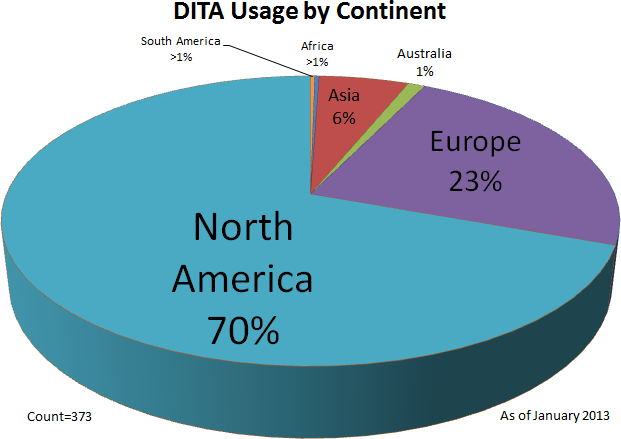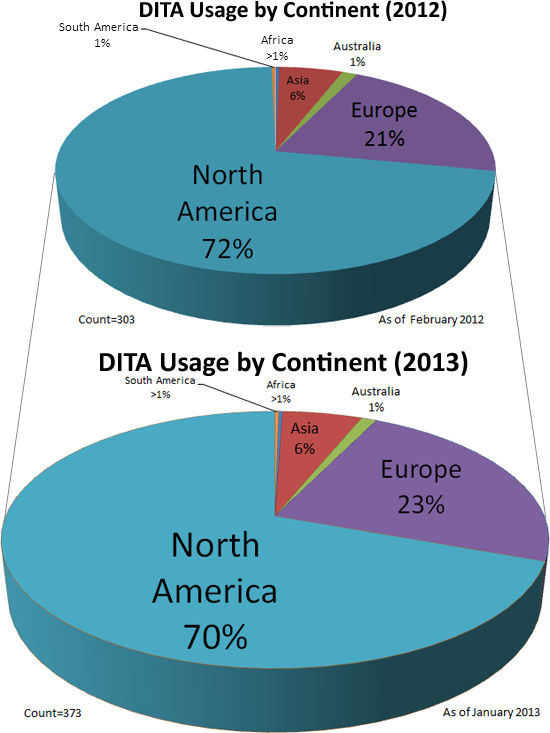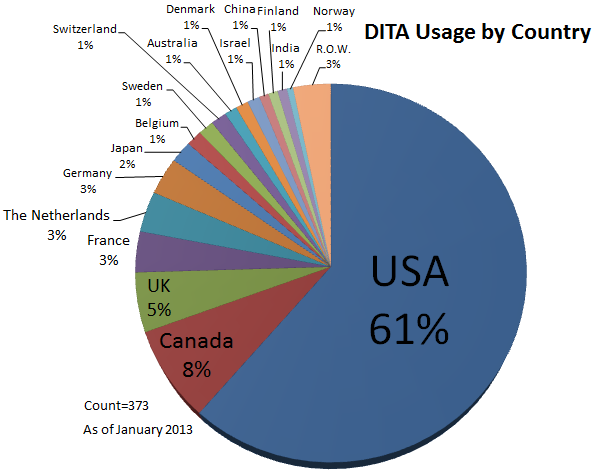Update: My thanks to Wim Hooghwinkel of Information Energy who sent me a list of a several firms in The Nederlands that are using DITA, which single-handedly pushed the numbers of firms for that country up a full percentage point. Also to my Mekon colleague Noz Urbina who pointed out a problem with the numbers on one of the charts, which I have corrected in this update. (It should also be noted that the way Excel rounds whole percentage figures is a bit wonky, but everything still adds up to 100).
The other day I released a significant update to the Companies Using DITA listing, which means that it is also time for me to update where DITA is being used across the world. When compiling the list I note where the HQ for that firm is situated. This may or may not be the same place where DITA is actually being used, as in some cases it may only be a single division or tech docs group with a company that is using it, but I have found the results that emerge to be interesting and over the past couple of years have proven to be surprisingly consistent in terms of the percentages.
Going by the numbers, by far the majority of companies using DITA are based out of North America, as you can see from the following pie chart:

If you compare this year’s pie chart to the one I did last year at first glance there’s only slight change, with Europe picking up a percentage overall from North America. What’s more significant is the size of the pie: this year’s chart represents an almost 20% growth over last year’s.

Sadly, the only continent still without any representation is Antarctica. Once again no one has thought to teach the penguins down there the benefits of using DITA… 😉

Country-by-Country Breakdown
Here is a complete breakdown of DITA usage by all countries in the world:

It should be of no surprise to anybody that the US is the hotbed for DITA usage throughout the world, and by itself holds the majority of all DITA-based firms in the world. After that comes Canada, then the UK, then France, The Netherlands and Germany, then a mix of European and Asian countries at or above the 1% mark. The key difference between this chart and the one from last year are the addition of Israel, China and India where usage has grown to represent a single percent apiece of the total. The countries comprising the Rest of World (R.O.W.) shown on the chart are:
- Hungary
- Ireland
- Italy
- Kenya
- Korea
- Pakistan
- Portugal
- R.O.C.
- Romania
- Russia
- Singapore
- Uruguay
One of the critiques that sometimes thrown at DITA is that it is an English-language only phenomenon, and yet the number of European and Asian firms that are using it would suggest otherwise. While a number of those firms are likely also authoring original material in English, it is unlikely that all of them are.
This survey update says to me that DITA XML adoption is a world-wide phenomenon, and that if you are on a documentation team using it, you are in increasingly good company!
Tomorrow: regional Distribution of DITA Usage in North America and in Europe.

An important related question is, “To what countries is DITA content being published.” I suspect that somewhere among the documentation for lab equipment in Antarctica is a help file or manual that was produced from DITA-authored source. 😉
Well, the other reason why Antarctica will forever be under-represented is that as far as I know no company is (or can be) incorporated there, as it is composed of territorial zones held by other countries. I *did* get a report from someone at a conference saying that there is a branch of the U.S. Army that produces manuals which are used at a research station in Antarctica, but I could never nail down anything more specific. Until then I have to assume that the penguins, seals, and the other weather-hardened creatures down there are ignorant of the benefits of DITA XML. 😉
As for your other question I am sure that DITA content is localized somewhere into just about all representative languages on the planet. If there was some way to specifically track DITA-produced output it would be much easier to answer this question.
We have 40+ authors in Japan, authoring in Japanese.
I understand that DITA is growing in Asia, especially in Japan. I heard yesterday about an upcoming conference (DITA Festa 2013) to be held in Japan sometime next month for which I am trying to find sufficient information to add to my DITA Conference page. I am particularly interested in hearing more about how DITA does (or does not) work well in an Asian-language setting. Cheers!
DITA Festa in Japan has been going on since 2010. I attended the first conference where Eliot Kimber talked about the ePub plugin for DITA.
You can check the DITA Consortium Japan website for more information about the next DITA Festa. It’s in Japanese, but Google Translate should help. I didn’t see anything about DITA Festa next month, so maybe it’s not DITA Festa. I’ll ask around.
In a nutshell, DITA authoring works well in Japanese, but there are quirks and several teething problems, especially with the tools. For example, in the beginning (2008) our XML editor could not handle Japanese character input very well. if you are familiar with IME (Input Method Editor), you’d want the text box and character palette to appear directly underneath whatever you’re typing. The earlier version of our XML editor puts the box in a fixed location on the top left corner of the window, so it’s very annoying for our Japanese authors. It’s been fixed now, but this is one of the usability problems that the mostly English-oriented tool providers don’t think about.
Another problem with the tools is search engines, which are probably not optimized for Chinese-Korean-Japanese (CJK). There are no spaces between Japanese characters, so when the author wants to search for “XYZABC” but accidentally types “XYZ ABC”, the search engine finds nothing.
Stylesheet development was also very challenging, because obviously rules in CJK are very different from English. For example, the stylesheet developer needs to understand where to insert line breaks in Japanese. In English, there are hyphenation and spaces, but there is none in Japanese, so the line breaking rules are completely different.
The major challenge (well, for me anyway) was finding a consultant or trainer who can conduct a DITA workshop in Japanese. In the end, I did it myself in English, with an interpreter. It was a real eye-opener for me, because I found that what I deemed important in a good technical document are not what the Japanese authors consider important. While I think content is the most important aspect, most Japanese authors think page layout is more important. It’s a constant struggle to find common ground, but we’re getting there.
DITA Festa Japan this year will be on Feb 7-8, with JoAnn Hackos as the keynote speaker, but I’m sure you know that by now (from Tetsuya).
Thanks for the information on DITA Festa Japan. I’ve added that information to my DITA Conferences page, which is so far all I have been able to find about the conference (at the moment there doesn’t seem to be any further information about it on the Japanese DITA Consortium page).
I have been in contact recently with Tetsuya, who has agreed to an interview on the DITAWriter.com once the conference is finished. The issues that you raise in your first comment here is exactly the sort of thing I am sure my readers would be interested in hearing more about — would you also be interested in contributing to an interview on this subject for the DITAWriter site?
Sure, as long as it is made clear that all the opinions are my own, not my employer’s. If you want to mention my employer anywhere in the article, our corporate comms people will need to approve it. Perhaps you can drop me an email to give me more details about what you have in mind?
Will do!